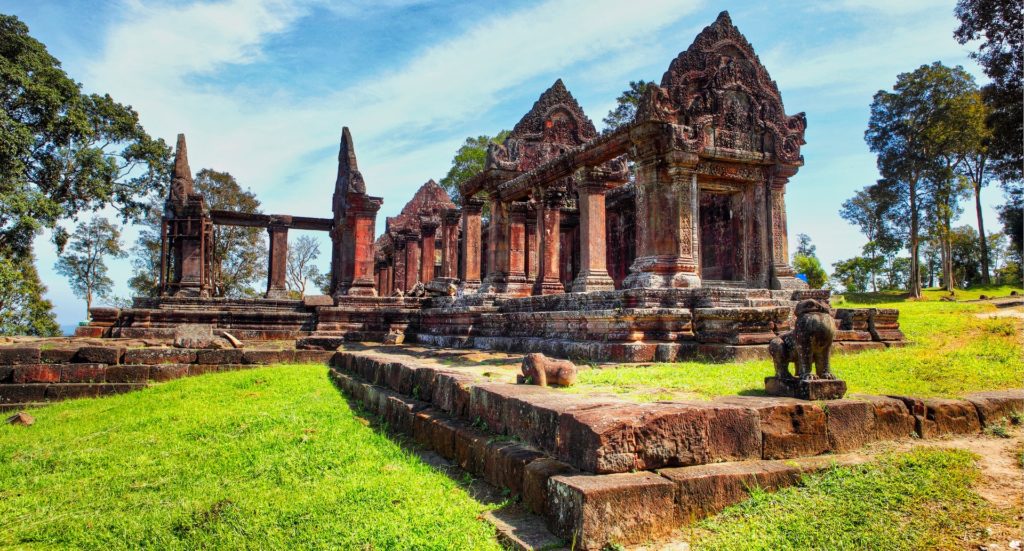Preah Vihear – a huge temple complex on a mountain
Preah Vihear is a region in the very north of Cambodia, where the eponymous temple complex of Prasat Preah Vihear is located. The temple directly adjoins the Thai border. The area has been the site of a border conflict between Cambodia and Thailand since the 1950s, with both nations claiming the temple complex and surrounding areas.

The Preah Vihear temple complex is located on the northern border of Cambodia on a mountain
Following the Franco-Siamese treaties of 1904 and 1907, which established the boundary line between Cambodia and Thailand along the Dongrak Mountains, the International Court of Justice in The Hague officially determined that Preah Vihear Temple was within Cambodian territory.
The area around Preah Vihear was or still is mined. Tourist paths have already been cleared of mines. However, mines could still be hidden in the immediate vicinity of the site (when leaving the paths). For example, a tuk-tuk driver recently triggered a mine when he walked off the trail a few hundred meters toward the edge of the forest
It is therefore advisable not to stray too far from the worn paths (and the temple complex itself).
The Hindu temple was built during the Khmer period, between the 10th and 12th centuries (from the researchers’ point of view, it is difficult today to determine the exact year in which the construction began, since the crucial clues, documentation or inscriptions are missing here). However, the style of the buildings indicates that they were built under the reign of King Yasovarman I.
Since it was one of the most important structures of the Khmer Empire, it was continuously expanded and enlarged – until it had the dimensions that captivate numerous visitors today. The last extensions took place under King Suryavarman II. This is a peculiarity in that it was common in the Khmer Empire for the kings to focus their construction resources primarily on building their own temples in order to perpetuate their rule in architectural terms and to set a monument to their power.
The Prasat Preah Vihear is a popular destination mainly because of its richly decorated walls and the beautiful surroundings – in which the temple complex is located and from which every visitor enjoys a magnificent view. Meanwhile, the complex is in ruins, but among the wall sections and door supports that have remained intact, there are numerous representations from Hindu mythology, which provide a good impression of the stories around the time of construction in terms of cultural studies. Prasat Preah Vihear is a Hindu temple dedicated to the deity Shiva, and was originally intended as a place of mental contemplation (such as meditation). For a long time, the complex was then also a popular destination for Hindu pilgrimages.
Due to the long construction period (or rather due to the step-by-step extensions), the Prasat Preah Vihear features very different architectural styles. Particularly exciting: The temple complex does not face east and is not designed in a rectangular shape, as is usually found in many temples of the Khmer Empire, but is oriented along the north-south axis. Since the area on which the buildings are erected is also a hilly landscape, these features were incorporated into the construction method. For example, there are similarities to a temple mountain due to the gradual rise (although Prasat Preah Vihear does not meet all the characteristics to be called so).
For visitors, travel is possible not only via Cambodia, but also via Thailand. From the Cambodian side, the temple complex can be reached both by car and, for example, as part of the many cycling tours offered. On the Thai side, the Khao Phra Viharn National Park directly adjoins the border. Access by car is possible without any problems (when visiting Prasat Preah Vihear, no separate Cambodian visa is required if visitors return within 24 hours and pay a small fee at the border).
The temple has been a UNESCO World Heritage Site since 2008, though the application reopened conflict between Thailand and Cambodia over the site’s rightful ownership. Protests erupted and also exchanges of fire between soldiers from the two countries, which ultimately resulted in fatalities
Most recently, in 2013, the International Court of Justice in The Hague once again invoked a 1962 ruling that the temple and its surrounding areas belonged to Cambodia. Since then, things have been quieter in this matter.